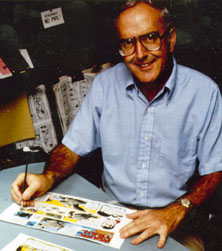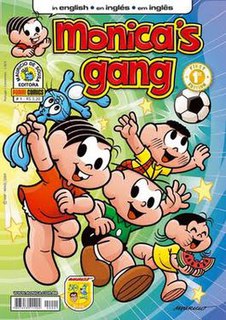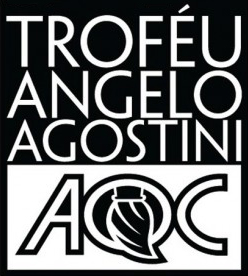Related Research Articles

José "Zé" Carioca is a cartoon anthropomorphic parrot created by the Brazilian cartoonist José Carlos de Brito and shown to Walt Disney in his trip to Rio de Janeiro in 1941. The Walt Disney Company then incorporated the idea, being introduced in the 1942 movie Saludos Amigos as a friend of Donald Duck, described by Time as "a dapper Brazilian parrot, who is as superior to Donald Duck as the Duck was to Mickey Mouse". He returned in the 1944 film The Three Caballeros along with Donald and a Mexican rooster named Panchito Pistoles. José is from Rio de Janeiro, Brazil.

A cartoonist is a visual artist who specializes in both drawing and writing cartoons or comics. Cartoonists differ from comic writers, comic book artists, or comic book illustrators in that they produce both the literary and graphic components of the work as part of their practice. Cartoonists may work in a variety of formats, including booklets, comic strips, comic books, editorial cartoons, graphic novels, manuals, gag cartoons, storyboards, posters, shirts, books, advertisements, greeting cards, magazines, newspapers, and video game packaging.

Monica's Gang or Monica and Friends is a Brazilian comic book series and media franchise created by Mauricio de Sousa.

The Prehistoric Rock-Art Site of the Côa Valley is an open-air Paleolithic archaeological site located in northeastern Portugal, near the border with Spain.

Monica is a Brazilian fictional character and Mauricio de Sousa's best-known creation. Introduced in 1963, she serves as the main protagonist and title character of the Monica's Gang comic book series and media franchise.

Brazilian comics started in the 19th century, adopting a satirical style known as cartoon, charges or caricature that would later be cemented in the popular comic strips. The publication of magazines dedicated exclusively to comics, in Brazil, started at the beginning of the 20th century. Brazilian artists have worked with both styles. In the case of American comics some have achieved international fame, like Roger Cruz with X-Men and Mike Deodato with Thor, Wonder Woman and others.
Comics has developed specialized terminology. Some several attempts have been made to formalize and define the terminology of comics by authors such as Will Eisner, Scott McCloud, R. C. Harvey and Dylan Horrocks. Much of the terminology in English is under dispute, so this page will list and describe the most common terms used in comics.
Dorath Pinto Uchôa was a Brazilian archaeologist and one of the founders of Brazilian Society of Archaeology. She specialized in the study of prehistoric coastal human settlements with a special emphasis on the study of prehistoric middens in the State of São Paulo, Brazil.
The Villa Lusitano-Romana de Torre de Palma, sometimes Villa Cardillio or Vila Cardílio is a Roman villa near Monforte in Portugal, which was in Roman times part of the province of Lusitania. It is considered one of the largest in the Iberian Peninsula. The prosperity of these latifundia in the region is often evidenced by shrines in the courtyard. In addition to the extensive living areas, a basilica and a seven-roomed baptistery have been uncovered in Torre de Palma.

André Diniz is a Brazilian comics artist. He began working with comics in 1994 with the fanzine Grandes Enigmas da Humanidade, which had a circulation of 5,000 copies.

Prêmio Angelo Agostini, sometimes also called Troféu Angelo Agostini, is the most traditional comics award in Brazil. It was created in 1985 by the Associação dos Quadrinhistas e Caricaturistas do Estado de São Paulo (AQC-ESP), which still organizes the event today.
Guia dos Quadrinhos is a Brazilian comic book database created with the objective of cataloging all comics published in Brazil, whether graphic novels, magazines, fanzines or independent publications.
Gedeone Malagola was a Brazilian comics artist and editor. He started his career in the 1940s, drawing for the newspaper A Marmita. He worked for several comic book publishers until he founded his own, Editora Júpiter. His main works were in the 1960s at GEP, where he created the superheroes Raio Negro, Hydroman and Homem Lua. In the late 1960s, Malagola wrote unofficial stories of the X-Men for GEP. In 1986, he was awarded the Prêmio Angelo Agostini for Master of National Comics, an award that aims to honor artists who have dedicated themselves to Brazilian comics for at least 25 years.
Waldyr Igayara de Souza was a Brazilian comic book artist and editor. He started his career working for the Outubro and Taika publishing houses, as well as the studio Alcântara Machado Propaganda, along with Lyrio Aragão, Julio Shimamoto and Luiz Saidenberg. In 1961, he started working at editora Abril, being one of the first Brazilian artists to work with Disney comics at the publishing house. He created the character Dugan Duck, nephew of Fethry Duck. The character was quite successful in Brazil and Italy, being the only duck with a yellow color. Igayara also worked as editorial director of Abril's children's division for 20 years, creating important children's magazines such as Recreio e Alegria. In 1993, he was awarded with the Prêmio Angelo Agostini for Master of National Comics, an award that aims to honor artists who have dedicated themselves to Brazilian comics for at least 25 years.
Fernando Ikoma is a Brazilian painter and comic book artist of Japanese descent. He moved to Curitiba at the age of 14, where he started working as an apprentice shop window designer. At 19, Ikoma started to work with comics in search of a better financial situation. He worked as a comic artist at EDREL, EBAL and Abril publishing houses. His main creation in the comics was the character Fikom, published by EDREL in the 1970s and whose adventures took place in the world of dreams, a place where his alter ego, the ugly Mukifa, could play the role of a beautiful hero. He also wrote the book A Técnica Universal das Histórias em Quadrinhos. Ikoma, however, left comics after some years to work as a painter.
Edson Rontani was a Brazilian illustrator and fanzine editor, known for having created the first Brazilian fanzine about comics.
Izomar Camargo Guilherme was a Brazilian comic artist. He started his career in the 1950s at La Selva publishing house. Among other children's characters, he created Zing Zong Crunch, the goblins Dingo and Dungo, the crazy duck Reco and the little native Bugrinho. Izomar also worked at Editora Abril with Disney comics in the 1960s, in addition to being art director and responsible for the publisher's comic book covers in the 1970s and 1980s. In 1992, he was awarded with the Prêmio Angelo Agostini for Master of National Comics, an award that aims to honor artists who have dedicated themselves to Brazilian comics for at least 25 years.
Flavio Soares is a Brazilian comics artist.
Bienal de Quadrinhos de Curitiba is a Brazilian comic book festival held since 2011 in Curitiba.
References
- 1 2 Ortiz Goulart, Fábio. "A Morte gótica: a Arqueologia nas Histórias em Quadrinhos" (PDF). Liber Studium - Laboratório de Arqueologia do Capitalismo. Universidade Federal do Rio Grande. Retrieved 8 June 2021.
- ↑ IANNONE, L. R.; IANNONE, R. A. (1994). O mundo das histórias em quadrinhos. São Paulo, Brazil: Moderna. ISBN 9788516010089.
- ↑ Swogger, John G. (2020). Prehistory, protest and public engagement: using comics and cartoons to tell the Old Oswestry story (Old Oswestry Hillfort and its Landscape: Ancient Past, Uncertain Future ed.). Oxford: Archaeopress Publishing. pp. 219–229. ISBN 9781789696127.
- ↑ Zarankin, Andrés; Zigarán, Iván (2020-11-24). "Archaeo-Becoming, Zarankin-Centrism and Contaminated Presents". Journal of Contemporary Archaeology. 7 (1): 48–60. doi:10.1558/jca.36915 . Retrieved 9 June 2021.